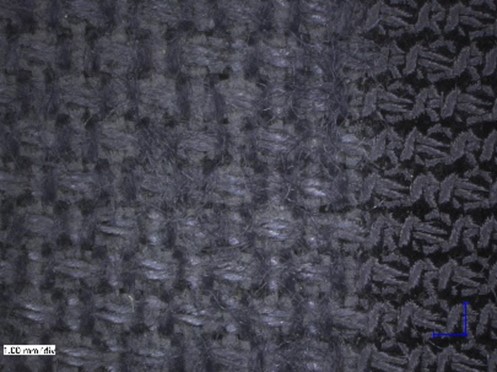Low-cost test setup for motorcycle protective clothing abrasion examination
DOI:
https://doi.org/10.25367/cdatp.2021.2.p196-207Keywords:
Low-cost test setup, motorcycle protective clothing, abrasion examination, textiles, self-build set-upAbstract
The personal protective equipment and protective clothing for motorcyclists reduce physical injuries to victims of road accidents. Therefore, it is important that the protective clothing complies with a number of test standards, which must be taken into account during the manufacturing process. However, the EN17092-1 to 6 standard does not necessarily correspond to a real accident situations and these testing procedures are time consuming. In this study, a simple and inexpensive self-constructed device for testing the abrasion resistance of motorcycle protective clothing was developed and evaluated. Different types of textiles and leather with and without coating were tested and compared. According to the results of this study, not only leather but also textiles offer good abrasion resistance results. The results show that the strength of an impact significantly changes the abrasion resistance. The developed test method can provide a good alternative as a low-cost and simple test method of abrasion resistance of motorcycle protective clothing.
References
Boon Hong Ang, Shaun Wen Huey Lee, Jennifer Oxley, Khai Khun Yap, Keang Peng Song, S. B. Kamaruzzaman, A. V. Chin, K. M. Tan, H. M. Khor, and Won Sun Chen. 2019. Self-regulatory driving and riding practices amongst older adults in Malaysia. Transp. Res. Part F Traffic Psychol. Behav. 62, 782-795. DOI: https://doi.org/10.1016/j.trf.2019.03.014.
Fábio A.O. Fernandes, Ricardo J.Alves de Sousa, Mariusz Ptak, and Gonçalo Migueis. 2019. Helmet design based on the optimization of biocomposite energy-absorbing liners under multi-impact loading. Appl. Sci. 9, 4, 1-26. DOI: https://doi.org/10.3390/app9040735.
Shriram Mukunthan, Jochen Vleugels, Toon Huysmans, Kalev Kuklane, Tiago Sotto Mayor, and Guido De Bruyne. 2019. Thermal-performance evaluation of bicycle helmets for convective and evaporative heat loss at low and moderate cycling speeds. Appl. Sci. 9, 18. DOI: https://doi.org/10.3390/app9183672.
Miguel Araujo, Eduardo Illanes, Evelina Chapman, and Eugênia Rodrigues. 2017. Effectiveness of interventions to prevent motorcycle injuries: systematic review of the literature. Int. J. Inj. Contr. Saf. Promot. 24, 3, 406-422. DOI: https://doi.org/10.1080/17457300.2016.1224901.
El Yamani Fouda, Mohamed Youssef, Sameh H. Emile, Hossam Elfeki, Waleed Thabet, Emad Abdallah, Ayman Elshobaky, Mohamed S. Toma, and Wael Khafagy. 2017. Pattern of major injuries after motorcycle accidents in Egypt: The Mansoura Emergency Hospital experience. Trauma (United Kingdom) 19, 1, 39-45. DOI: https://doi.org/10.1177/1460408616652924.
Longina Madej-Kiełbik, Katarzyna Kośla, Dorota Zielińska, Edyta Chmal-Fudali, and Magdalena Maciejewska. 2019. Effect of accelerated ageing on the mechanical and structural properties of the material system used in protectors. Polymers (Basel). 11, 8. DOI: https://doi.org/10.3390/polym11081263.
Lauren Meredith, Christopher Hurren, Elizabeth Clarke, Michael Fitzharris, Matthew Baldock, Liz de Rome, Jake Olivier, and Julie Brown. 2017. Validation of the abrasion resistance test protocols and performance criteria of EN13595: The probability of soft tissue injury to motorcycle riders by abrasion resistance of their clothing. J. Safety Res. 61, 1-7. DOI: https://doi.org/10.1016/j.jsr.2017.02.001.
Motohart UK Ltd. 2016. CE-booklet-clothing-Curved.pdf. Harvey Combe, Killingworth, NE 12 6QQ. Available on: https://www.viperrider.com /eudoc17902 (accessed on October 28, 2021).
Slovenski inštitut za standardizacijo. 2000. Slovenski Standard SIST EN 61310-3:2000. https://standards.iteh.ai/catalog/standards/sist/76ac0d7f-e1a3-4311-9f95-27768b6746a3/sist-en-61310-3-2008 (accessed on December 17, 2021).
Beuth Verlag GmbH. 2021. Avaliable on: https://www.beuth.de/de/erweiterte-suche/272754!search?alx.searchType=complex&searchAreaId=1&query=Motorradfahrer&facets%5B276612%5D=&hitsPerPage=10 (accessed on October 21, 2021).
Nicolai Bollschweiler, Sascha Marzen, and Andrea Ehrmann. 2018. New method to measure abrasion of motorcyclist protective clothing. Tekstilec 61, 3, 152-161. DOI: https://doi.org/10.14502/tekstilec2018.61.152-161.
Liz de Rome, Rebecca Ivers, Michael Fitzharris, Wei Du, Narelle Haworth, Stephane Heritier, Drew Richardson. 2011. Motorcycle protective clothing: Protection from injury or just the weather? Accident Analysis & Prevention 43, 6,1893-1900. https://doi.org/10.1016/j.aap.2011.04.027.
Bianca Albanese, Tom Gibson, Tom Whyte, Lauren Meredith, Giovanni Savino, Liz de Rome, Matthew Baldock, Michael Fitzharris, and Julie Brown. 2017. Energy attenuation performance of impact protection worn by motorcyclists in real-world crashes. Traffic Inj. Prev. 18, S1, S116-S121. DOI: https://doi.org/10.1080/15389588.2017.1311014.
Rafael Ekmejian, Pooria Sarrami, Justine M. Naylor, and Ian A. Harris. 2016. A systematic review on the effectiveness of back protectors for motorcyclists. Scand. J. Trauma. Resusc. Emerg. Med. 24, 1, 115. DOI: https://doi.org/10.1186/s13049-016-0307-3.
Marco Giustini, Sabina Cedri, Marco Tallon, Paolo Roazzi, Rita Formisano, and Alessio Pitidis. 2014. Use of back protector device on motorcycles and mopeds in Italy. Int. J. Epidemiol. 43, 6, 1921-1928. DOI: https://doi.org/10.1093/ije/dyu209.
Sayyed Hoseinian, S. H., Ebrahimzadeh, M. H., Peivandi, M. T., Bagheri, F., Hasani, J., Golshan, S., & Birjandinejad, A. 2019. Injury Patterns among Motorcyclist Trauma Patients: A Cross Sectional Study on 4200 Patients. The Archives of Bone and Joint Surgery 7(4), 367–372. PMID: 31448315; PMCID: PMC6686071.
Liz de Rome. 2019. Could wearing motorcycle protective clothing compromise rider safety in hot weather? Accid. Anal. Prev. 128, 240-247. DOI: https://doi.org/10.1016/j.aap.2019.04.011.
Eleni Petridou and Maria Moustaki. 2000. Human Factors in the Causation of Road Traffic crashes. Eur. J. Epidemiol. 16, 9, 819-826.
Patrick Seiniger, Kai Schröter, and Jost Gail. 2012. Perspectives for motorcycle stability control systems. Accid. Anal. Prev. 44, 1, 74-81. DOI: https://doi.org/10.1016/j.aap.2010.11.018
Mustafa Talib Yousif, Ahmad Farhan Mohd Sadullah, and Khairil Anwar Abu Kassim. 2020. A review of behavioural issues contribution to motorcycle safety. IATSS Res. 44, 2, 142-154. DOI: https://doi.org/10.1016/j.iatssr.2019.12.001.
Dan Halbersberg and Boaz Lerner. 2019. Young driver fatal motorcycle accident analysis by jointly maximizing accuracy and information. Accid. Anal. Prev. 129, 350-361. DOI: https://doi.org/10.1016/j.aap.2019.04.016

Downloads
Published
How to Cite
Issue
Section
License
Copyright (c) 2021 Dietrich Spädt, Imane Moulefera, Al Mamun, Marah Trabelsi, Lilia Sabantina

This work is licensed under a Creative Commons Attribution-NonCommercial-NoDerivatives 4.0 International License.





